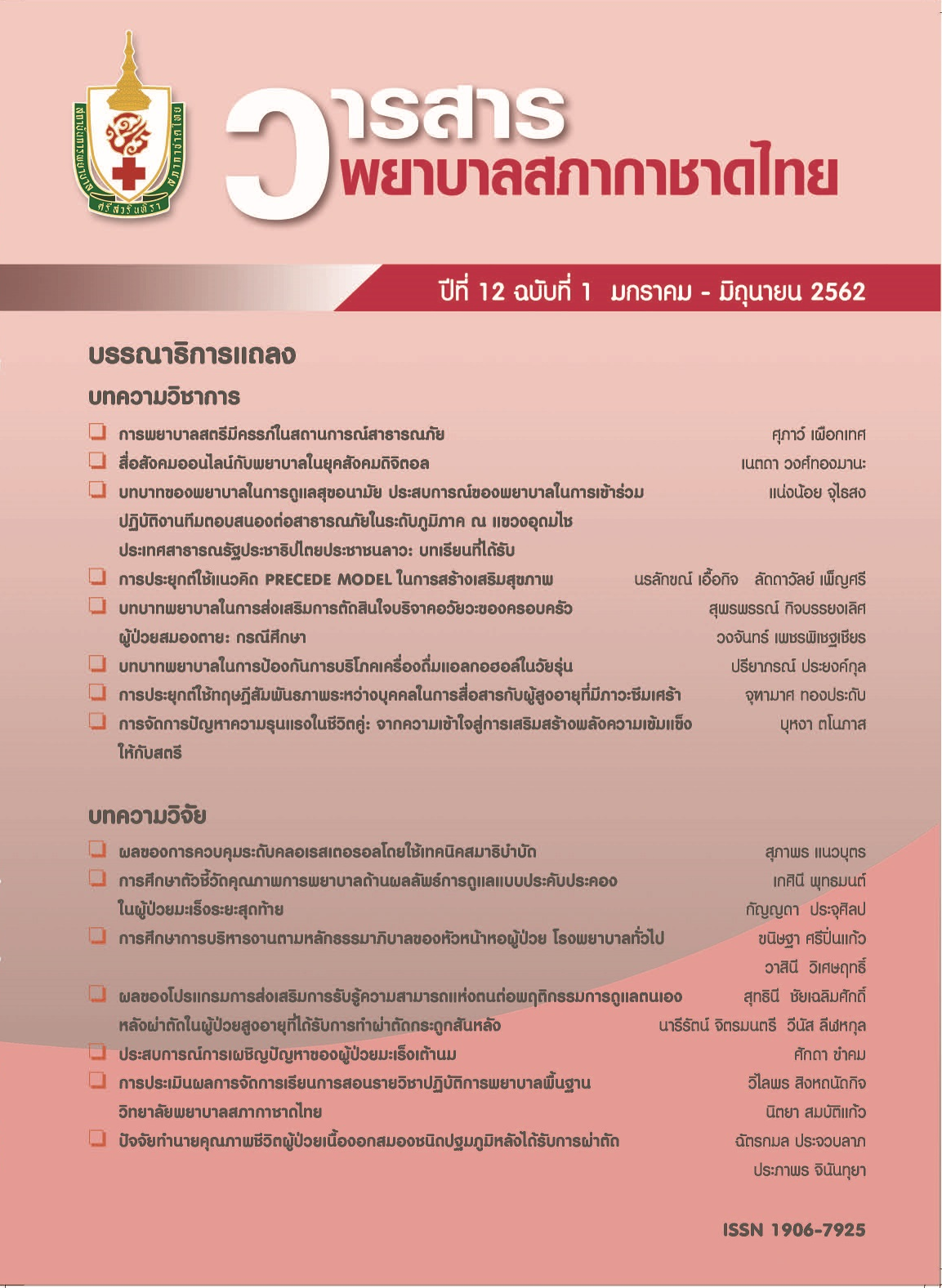Management of the Problem of Intimate Partner Violence: From Understanding to Empowering Women
Keywords:
intimate partner violence, empowerment, womenAbstract
Intimate partner violence (IPV) is serious and a widespread public problem worldwide that violates basic human rights. Understanding the issues related to IPV will guide prevention and long term care. This article provides the meaning and typology of IPV, risk factors, protection factors, the impact of IPV and the prevention of IPV. The prevention of IPV consists of three levels. Primary prevention is to prevent the IPV situation occurring. Secondary prevention aims to prevent the repetition of IPV situation such as screening and managing the risk factors of IPV. Finally, tertiary prevention focuses on preventing death, trauma, disability and treats the impact of the violence. Empowerment through thinking and the decision making process by women should be addressed when supporting her in surviving violence.Additionally, the autonomy of the abused woman should be respected. The goal of all strategies for helping women who suffer from IPV are reducing short-term and long-term consequences, helping women to be safe and gain power to create sustainable change for ending the violence.
References
2. Ahmadabadi Z, Najman JM, Williams GM, Clavarino AM, d'Abbs P. Gender differences in intimate partner violence in current and prior relationships. J Interpers Violence 2017:886260517730563. doi: 10.1177/0886260517730563.
3. กระทรวงการพัฒนาสังคมและความมั่นคงในมนุษย์ กรมกิจการสตรีและสถาบันครอบครัว. รายงานข้อมูลสถานการณ์ด้านความรุนแรงในครอบครัว สำหรับการรายงานตามมาตรา17 แห่งพระราชบัญญัติคุ้มครองผู้ถูกกระทำด้วยความรุนแรงในครอบครัว พ.ศ.2550 ประจำปี 2558 [อินเทอร์เน็ต]. 2558 [เข้าถึงเมื่อ 1 ก.พ. 2562]. เข้าถึงได้จาก: https://library2.parliament.go.th/giventake/content_nla2557/d120859-06.pdf
4. Suvetwethin D. เปิด ‘10 คำดี-ร้าย’ ในครอบครัว [อินเทอร์เน็ต]. 2560 [เข้าถึงเมื่อ 1 ก.พ. 2562]. เข้าถึงได้จาก: http: //www.thaihealth.or.th/Content/39586-เปิด%20/'10คำดี-ร้าย/'%20ในครอบครัว.html.
5. World Health Organization. Violence against women: intimate partner and sexual violence against women [Internet]. 2016 [cited 2019 Feb 2]. Available from: https://www.who.int/mediacentre/ factsheets/fs239/en/
6. United Nations Assembly. The united nations work on violence against women [Internet]. 1993 [cited 2019 Feb 2]. Available from: https://www.un.org/womenwatch/daw/news/unwvaw.html.
7. พระราชบัญญัติคุ้มครองผู้ถูกกระทำด้วยความรุนแรงในครอบครัว พ.ศ. 2550 [อินเทอร์เน็ต]. 2550 [เข้าถึงเมื่อ 1 ก.พ. 2562]. เข้าถึงได้จาก: https://www.jvnc.coj.go.th/doc/data/jvnc/jvnc_1492483871.PDF
8. Breiding MJ, Basile KC, Smith SG, Black MC, Mahendra R. Intimate partner violence surveillance: uniform definition and recommended data elements, version 2.0 [Internet]. Atlanta (GA): National Center for Injury Prevention and Control, Centers for Disease Control and Prevention; 2015 [cited 2019 Feb 2]. Available from: https://www.cdc.gov/violenceprevention/pdf/ipv/intimatepartnerviolence.pdf
9. Johnson MP. Patriarchal terrorism and common couple violence: two forms of violence against women. J Marriage Fam 1995;57(2):283-94.
10. กฤตยา อาชวนิจกุล, ชื่นฤทัย กาญจนะจิตรา, วาสนา อิ่มเอม. รายงานการวิจัยเรื่องความรุนแรงในชีวิตคู่กับสุขภาพผู้หญิง. นครปฐม: สถาบันวิจัยประชากรและสังคม มหาวิทยาลัยมหิดล; 2546.
11. Tanopas B, Phancharoenworakul K, Kasemkitwatana S, Vorapongsathon T. Development and psychometric testing of the abused wife coping scale. Thai Journal of Nursing Research 2006;10(4):229-41.
12. Ali PA, Dhingra K, McGarry J. A literature review of intimate partner violence and its classifications. Aggress Violent Behav 2016;31:16-25.
13. Niolon PH, Kearns M, Dills J, Rambo K, Irving S, Armstead T, Gilbert L. Preventing intimate partner violence across the lifespan: a technical package of programs, policies, and practices [Internet]. Atlanta, GA: National Center for Injury Prevention and Control, Centers for Disease Control and Prevention; 2017 [cited 2019 Feb 2]. Available from: https://www.cdc.gov/violenceprevention/pdf/ipv-technicalpackages.pdf
14. Center of Disease Control and Prevention. Principle of prevention guide [Internet]. 2015 [cited 2019 Feb 2]. Available from: https://vetoviolence.cdc.gov/apps/pop/assets/pdfs/pop notebook.pdf
15. Stockman JK, Hayashi H, Campbell JC. Intimate partner violence and its health impact on disproportionately affected populations, including minorities and impoverished groups. J Womens Health 2015;24(1):62-79.
16. Trevillion K, Oram S, Feder G, Howard LM. Experiences of domestic violence and mental disorders: a systematic review and meta-analysis. PLOS ONE 2012;7(12):e51740.
17. Wong J, Mellor D. Intimate partner violence and women’s health and wellbeing: impacts, risk factors and responses. Contemp Nurse 2014;46(2):170-9.
18. Wathen CN, MacMillan HL. Children’s exposure to intimate partner violence: impacts and interventions. Paediatr Child Health 2013;18(8):419-22.
19. Black MC, Basile KC, Breiding MJ, Smith SG, Walters, ML, Merrick MT, et al. The National Intimate Partner and Sexual Violence Survey (NISVS): 2010 summary report. Atlanta, GA: National Center for Injury Prevention and Control, Centers for Disease Control and Prevention; 2011.
20. World Health Organization. Prevent intimate partner and sexual violence against women: Taking action and generating evidence [Internet]. 2010 [cited 2019 Feb 2]. Available from: https://www.who.int/violenceinjuryprevention/publications/violence/9789241564007_eng.pdf
21. World health organization. Intimate Partner Violence. The violence prevention information system [Internet]. 2017 [cited 2019 Feb 2]. Available from: https://apps.who.int/violence-info/intimate-partner-violence
22. Dahlberg LL, Krug EG. Violence-a global public health problem. In: Krug EG, Dahlberg LL, Mercy JA, Zwi AB, Lozano R, editors. World report on violence and health. Geneva, World Health Organization; 2002. p. 3–21.
23. Kirk L, Terry S, Lokuge K, Watterson JL. Effectiveness of secondary and tertiary prevention for violence against women in low and low-middle income countries: a systematic review. BMC Public Health 2017;17(1):622.
24. บุหงา ตโนภาส, ศุภาว์ เผือกเทศ, สุรีย์ ปิ่นตาสา, พรลดา ณ นคร. อัตราความชุกและปัจจัยเสี่ยงต่อการเกิดความรุนแรงในชีวิตคู่ในสตรีที่ใช้บริการที่แผนกสูตินรีเวชกรรม โรงพยาบาลสมเด็จพระบรมราชเทวี ณ ศรีราชา. วารสารสภาการพยาบาล 2553;25(3):64-76.
25. Kiely M, El-Mohandes AA, El-Khorazaty MN, Blake SM, Gantz MG. An integrated intervention to reduce intimate partner violence in pregnancy: a randomized controlled trial. Obstet Gynecol 2010;115(2 Pt 1):273-83.
26. Miller E, Decker MR, McCauley HL, Tancredi DJ, Levenson RR, Waldman J, et al. A family planning clinic partner violence intervention to reduce risk associated with reproductive coercion. Contraception 2011;83(3):274-80.
27. Miller E, Tancredi DJ, Decker MR, McCauley HL, Jones KA, Anderson H, et al. A family planning clinic-based intervention to address reproductive coercion: a cluster randomized controlled trial. Contraception 2016;94(1):58-67.
28. Sharps PW, Bullock LF, Campbell JC, Alhusen JL, Ghazarian SR, Bhandari SS, et al. Domestic violence enhanced perinatal home visits: the dove randomized clinical trial. J Womens Health 2016;25(11):1129-38.
29. Zaher E, Keogh K, Ratnapalan S. Effect of domestic violence training: systemic review of randomized controlled trials. Can Fam Physician 2014;60(7):618-24.
30. Ofstehage A, Gandhi A, Sholk J, Radday A, Stanzler C. Empowering victims of domestic violence. social issue report, september, 1-6 [Internet]. 2011 [cited 2019 Feb 2]. Available from: https://www.rootcause.org/docs/Resources/Research/Empowering-Victims-of-Domestic-Violence /Empowering/Report.pdf
31. Johnson MP, Ferraro KJ. Research on domestic violence in the 1990s: making distinctions. J Marriage Fam 2000;62(4):948-63.
32. Friend DJ, Bradley RPC, Thatcher R, Gottman JM. Typology of intimate partner violence: evaluation of a screening instrument for differentiation. J Fam Violence 2011;26:551-63.
Downloads
Published
Issue
Section
License
เนื้อหาบทความหรือข้อคิดเห็นต่างๆ ในวารสารพยาบาลสภากาชาดไทยนี้ เป็นความคิดเห็นของผู้เขียนบทความ ไม่ใช่ความเห็นของกองบรรณาธิการ หรือสถาบันการพยาบาลศรีสวรินทิรา สภากาชาดไทย





